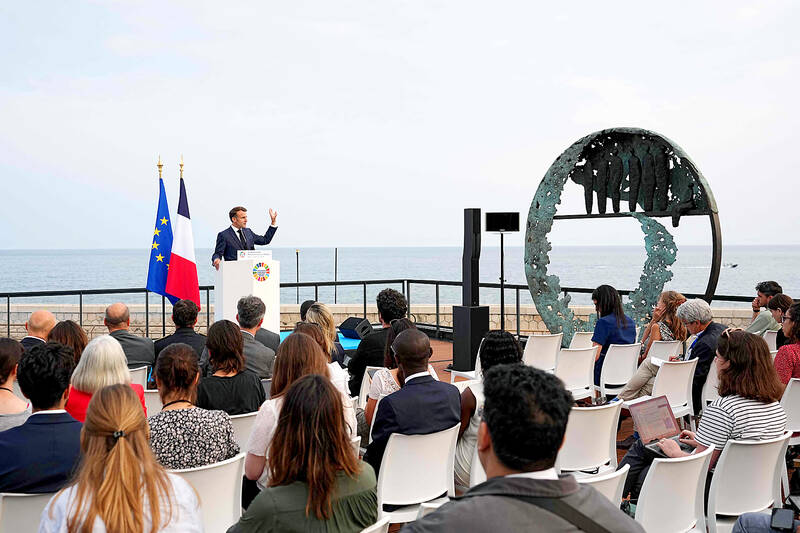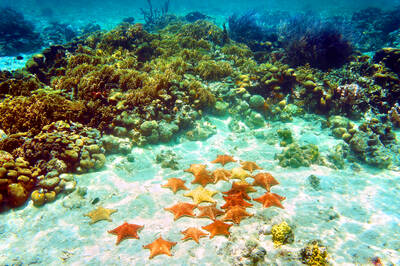The UN Ocean Conference wrapped up in Nice, France on Friday last week with world leaders taking major steps toward marine protection and vowing a showdown when nations meet to negotiate rules for deep-sea mining next month. But a lack of funding pledges and the total omission of fossil fuels disappointed some observers.
The summit was just the third — and largest yet — dedicated entirely to what the United Nations calls an “emergency” in the world’s oceans.
The High Seas Treaty, or Global Ocean Treaty, is also known as the Agreement under the United Nations Convention on the Law of the Sea (UNCLOS) on the Conservation and Sustainable Use of Marine Biological Diversity of Areas beyond National Jurisdiction and the Biodiversity Beyond National Jurisdiction (BBNJ) Agreement. It was adopted by UN member states in June 2023, and has been ratified by 50 nations plus the European Union. It comes into force 120 days after its 60th ratification.

Photo: AFP 照片:法新社
France’s oceans envoy, Olivier Poivre d’Arvor, said the numbers would be reached by September and the treaty should take effect by January of next year, affording protection to marine life in the vast swathes of ocean under the control of no single state.
Key points of the treaty text include:
INTERNATIONAL WATERS

Photo: AFP 照片:法新社
The treaty covers international waters, which fall outside the jurisdiction of any single state, and account for more than 60 percent of the world’s oceans.
Specifically, it applies to waters beyond countries’ exclusive economic zones, which extend up to 200 nautical miles from the coast.
It also covers what is known as “the Area,” shorthand for seabed and subsoil beyond the limits of national jurisdiction. The Area comprises just over half of the planet’s seabed.

Photo: AFP 照片:法新社
Once enacted, a decision-making body — a Conference of the Parties (COP) — would have to work with regional and global organizations that already oversee different aspects of the oceans.
These include regional fisheries bodies and the International Seabed Authority, the arena where nations are hotly contesting a proposed set of rules to govern deep-sea mining.
MARINE PROTECTED AREAS
Currently, almost all protected marine areas (MPAs) are within national territorial waters.
The treaty, however, allows for these reserves to be created in the open ocean.
One crucial shortcoming: the text does not say how these conservation measures will be monitored and enforced over remote swathes of the ocean — a task that will fall to the COP.
Experts say satellites could be used to spot infractions.
Individual countries are already responsible for certain activities on the high seas that they have jurisdiction over, such as those of ships flying their flags.
SHARING THE BOUNTY?
On the high seas, countries and entities under their jurisdiction will be allowed to collect animal, plant, or microbial matter whose genetic material might prove useful, even commercially.
Benefits-sharing of those resources has been a key point of contention between wealthy and poorer nations.
ENVIRONMENTAL IMPACT STUDIES
The treaty requires signatories to assess the environmental impacts of planned activities under their control on the high seas before they are authorized in instances when such activities may have more than a minor or transitory effect.
It also calls for countries to assess the potential impact on international waters of activities within national jurisdictions that may cause “substantial pollution” or harm the high sea marine environment.
Though they are not specifically listed in the treaty, activities that could come under regulation include transport and fishing, as well as more controversial subjects such as deep-sea mining or even geo-engineering initiatives to mitigate global warming. (AFP)
聯合國海洋大會上週五在法國尼斯閉幕,各國領導人在保護海洋方面邁出了重要的一步,並誓言在下個月各國就深海採礦法規進行談判時亮牌決勝。然而,此次大會缺乏資金承諾以及完全忽略化石燃料問題,令一些觀察家感到失望。
此峰會是第三次——也是迄今規模最大的——專門討論聯合國所稱的全球海洋「緊急狀態」的峰會。
「公海條約」(又稱「全球海洋公約」),即「《聯合國海洋法公約》(UNCLOS)關於國家管轄範圍以外區域海洋生物多樣性保育與永續利用協定」(BBNJ協定),於2023年6月由聯合國成員國通過。該條約已獲得50個國家及歐盟的批准,並將在第60個批准國批准後的120天生效。
法國海洋特使奧利維耶.普瓦夫爾.達沃爾表示,批准的國家數目將在9月達標,條約應於2026年1月生效,為這片廣闊、不屬於任何人的海域中的海洋生物提供保護。
該條約之要點如下:
國際水域
該條約所規定的範圍是國際水域,即任一國家管轄範圍以外之水域,這佔了全球海洋面積的60%以上。
具體而言,該條約適用於各國專屬經濟區以外之水域,專屬經濟區的範圍是由海岸向外推至200海浬。
條約也涵蓋國家管轄範圍以外的海床與底土,簡稱〔海底〕「區域」,這佔了地球海床面積的一半多一些。
條約一旦頒布,決策機構──締約方大會(COP)──將必須與監管海洋不同面向的現行區域及全球組織合作。
這些組織包括區域漁業機構和國際海底管理局,各國正在就一套研擬中的深海採礦管理法規展開激烈辯論。
海洋保護區
目前,幾乎所有海洋保護區(MPA)都位於國家領海內。
但「公海條約」讓公海也能設立保護區。
一個關鍵的缺陷是:條約內容並未說明如何在偏遠的海域監測和執行這些保護措施──這項任務將由締約國大會承擔。
一些專家表示,衛星可以用來偵測違法行為。
各國對公海上其管轄範圍內的某些活動已負有責任,例如懸掛其國旗之船舶的活動。
分享收益?
在公海上,其管轄範圍內的國家和實體將可採集動物、植物或微生物,其遺傳物質可能會有用處,甚至具有商業價值。
這些資源的利益分享一直是富國和窮國之間爭論的關鍵點。
環境影響研究
該條約要求締約國在核准公海活動前,先評估其可能造成之影響,是否只有輕微或短暫的環境影響。
條約還要求各國評估其在國際水域的活動是否會造成「嚴重污染」,或可能損害公海之海洋環境。
雖然條約並未明確列出,但可能受到監管的活動包括運輸和漁業,以及一些更具爭議性的議題,例如深海採礦,甚至旨在緩解全球暖化的地球工程(geo-engineering)措施。
(台北時報林俐凱編譯)

In English, “name idioms” are part of what makes English fascinating. Let’s put a few examples under the microscope. Doubting Thomas This expression stems from the Bible. Thomas, one of Jesus’s disciples, refused to believe Jesus had been resurrected from the dead. He declared he wouldn’t accept it until he could see the nail marks in Jesus’s hands and touch his wounds himself. Today, this idiom refers to someone who won’t believe something without concrete evidence. For instance, if your friend’s expertise is reliable, but you’re still suspicious, you might be a “doubting Thomas.” Smart Aleck The origin of this phrase likely comes from

A: Hey, the world’s major dictionaries just unveiled their words of the year for 2025. B: Yup, the Cambridge Dictionary chose the word “parasocial,” which refers to a connection that someone feels between themselves and a famous person they don’t really know. A: One-sided parasocial relationships with celebrities, influencers and even AI chatbots have clearly become more common. B: The Oxford Dictionary picked “rage bait” — online content designed to elicit anger by being frustrating, provocative or offensive in order to increase traffic to Web sites or social media accounts. A: The Collins Dictionary picked “vibe coding.” Let’s

A: Apart from the world’s major dictionaries, the online Dictionary.com actually picked “67” as its word of the year. B: What does “67” even mean? A: Even the dictionary wasn’t exactly sure about its meaning. The slang term’s origin might be traced to US rapper Skrilla’s song Doot Doot (67). Aren’t Taiwanese media outlets choosing the Mandarin word for 2025? B: Yeah and after hearing the song Good-for-Nothing, adapted from some catchphrases of Legislator Wang Shih-chien, I’m going to vote for the character “tsung” (hasty) from the lyrics. A: Hopefully, in the new year, we’ll be calm as the

Sea star wasting disease (SSWD) is a strange and serious illness affecting sea stars, or starfish. This disease causes sea stars to develop painful lesions, lose their arms, and eventually turn into a gooey, melted mess. Since it was first observed in 2013, millions of sea stars along the Pacific coast of North America have died from this __1__. Although viruses were once considered a possible cause, researchers now believe that environmental stressors and microorganisms are primarily __2__ for sea star wasting disease. One of the main environmental triggers appears to be warmer ocean water. When the water heats